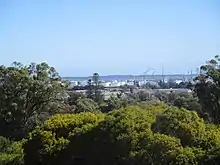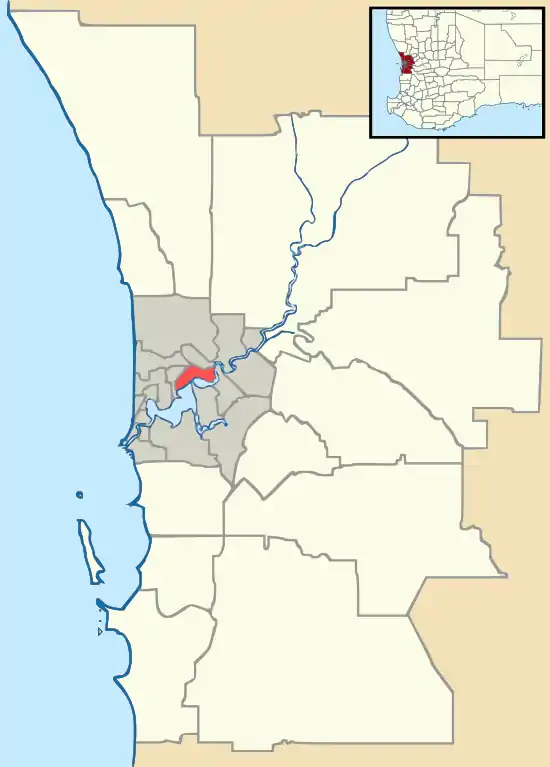Kwinana Oil Refinery
The Kwinana Refinery, operated by BP, is located on the shore of Cockburn Sound at Kwinana, near Fremantle, Western Australia. It was constructed by the then Anglo-Iranian Oil Company and completed in 1955.[1] It is the largest oil refinery in Australia, with a capacity of 138,000 barrels per day (21,900 m3/d).[2]
 Kwinana Oil Refinery, seen from Chalk Hill Lookout | |
 Location of Kwinana Refinery | |
| Country | Australia |
|---|---|
| City | Kwinana |
| Coordinates | 32.2295°S 115.7649°E |
| Refinery details | |
| Owner(s) | BP |
| Commissioned | 1955 |
| Capacity | 138,000 bbl/d (21,900 m3/d) |
History
The announcement of an £40 million agreement was made on 3 March 1952 when Premier Ross McLarty, Minister of Works David Brand and Coordinator of Works and Industrial Development Russell Dumas signed it on behalf of the state government at the premiers office.[3]:1 Eric Drake the chief negotiator for the Anglo-Iranian Oil Company, project manager W.K. Barker and P. Hackforth-Jones signed on behalf the company.[3]:1 The facility's name was announced as the Kwinana Refinery.[4] The agreement was then sent to parliament for reading as two bills on 6 March, one, Oil Refinery Industry Bill, to ratify the agreement and the second, Industrial Development (Kwinana Area) Bill, to acquire the land in Kwinana.[3]:1
Details in this final agreement included the company pay at least 6% of the dredging costs of the Cockburn Sound which would cost between £4 and £6 million as well as the State meeting the company's requirements for the dredge; supply of 12,000 kilowatts of electricity; cement to be imported by the company; sale of 75 acres of land to the south of the refinery for recreation and amenities; state to supply water and sewage to the construction and final building; supply potable water of 200,000 gallons a day rising to 3 million gallons a day; sale of land at £80 an acre; federal government to assist in supplying migrants for the project; State to build 1,000 rental homes within three years supplied with water, sewage and fences and roads to the refinery.[5]:6 Also included were details about three pipelines that company required built, one to Fremantle, a second from Fremantle to Perth and lastly a direct one to Perth; the tax on the oil in the pipelines was outlined and the land rates to be billed.[5]:6
In the second bill, land for future industry was proposed and would stretch from Robbs Jetty south towards Rockingham Townsite and east to Jandakot, with it acquired at a reasonable price.[6]:6 Resumption of land would take place up until 31 December 1953 and possibly beyond.[7]:7 Both bills passed the Legislative Council on 14 March 1952 and were sent to Governor Sir Charles Gairdner for his signature into law.[8]:1
At a meeting held in Canberra with Interior Minister Kent Hughes, the federal government agreed on 18 March 1952 to sell-back 949 acres it had owned, since its purchase in 1916, to the WA State Government at £10 acre.[9]:6 He also agreed to return Commonwealth land, from Woodman Point up to Kwinana, to the State for use as industrial land.[9]:6 Concerned about the impact of the project on the disruption to sources of labour in WA, Brand discussed immigration policy to make up the shortfall especially when it came to skilled workers.[9]:6 Discussion also took place as to Australian import restrictions when it came to material required for the refinery's construction, with the company willing to use local supplies but not to the detriment of the State's requirements for construction materials in other local projects.[9]:6
In May 1952, the State government authorised the commencement of a 19 km, 26 cm steel water pipeline from Melville reservoir to a 36.5m diameter, 1 million gallon storage tank on Mt Brown in Henderson, with completion in August and July respectively and on to the refinery site for use during construction.[10]:1[11]:3 Also in late May, A.E. Mason arrived to become the head of the project in Western Australia for the Anglo-Iranian Oil Company.[12]:5 Work also proceed on soil surveys, hydrographic surveys and pile tests at the project site.[12]:5 Tenders for the dredging of the Cockburn Sound would close in June 1952 with six tenders received for work to last 3 or 4 years, dredging through two banks, 4.4 km long channel through the Success Bank and 2.8 km long channel through the Parmelia Bank.[13]:5[14] Investigations took place in May 1952 to extend the existing railway line 9.8 km from Woodman Point and Coogee through to refinery site.[15]:1 But by July 1952, the railway plan was modified with an extension line from a future Welshpool railway line through Bibra Lake to the proposed Coogge line to Kwinana.[16]:4 The main water supply for the project would come through a 76 cm trunk-line from Armadale to a hill sited west of Lake Thompson were a 20,000,000 gallon reservoir would be built from late 1952 with pipeline to the refinery with completion in mid-1955.[17]:9
On the 24 September 1952, Anglo-Iranian Oil announced that Kelloggs International and Costain-John Brown & Company would build the refinery and its facilities.[18]:1 In late September 1952, the last obstacle preventing the refinery project proceeding, the Commonwealth Oil Refineries, equally owned by the Commonwealth and Anglo-Iranian and responsible for marketing refined products in Australia, would be sold so that it was fully owned by the latter.[19]:1 With this news, the dredging tender was announced on 1 October 1952 by Minister David Brand with the initial contract awarded for £2 million to a Dutch company, Hollandse Aanneming Maatskappy and would see a 152m wide, 11.5m deep channel created through the two banks with 7 million cubic yards of spoil removed, allowing 40,000 ton ships to enter the Cockburn Sound.[20] The spoil would deposited at three sites, Cockburn Sound, Owen Anchorage and Gage Roads.[21]:1 The refinery project's commencement was officially announced by Premier McLarty on 9 October 1952.[22]:4 Tenders for the 1,000 new rental houses were sent out in November 1952 for delivery in three years with five tenders chosen in mid-December to begin work mid-January 1953.[23]:5[24]:6
The refinery's twelve administrative building were completed in December 1954 after construction had started in May of the same year.[25]:6 On 8 January 1955, the first oil tanker British Crusader for the new refinery arrived at Gage Roads and would pass through the new channels into Cockburn Sound on 11 January.[26]:20 The first oil was pumped from the storage tanks into the distillation furnace on 2 February 1955 and the refinery was online.[27]:6 Petrol was pumped for the first time on 23 March 1955 from the refinery to the Commonwealth Oil Refineries depot in North Fremantle.[28] The refinery was officially opened on 25 October 1955 by the Governor-General Sir William Slim.[29]:3
Refining activities are to cease in 2021, with it to be converted to an oil import terminal.[30]
Engineering heritage
The refinery received a Historic Engineering Marker from Engineers Australia as part of its Engineering Heritage Recognition Program.[31]
Notes
- This is Kwinana Argus, 26 April 1955, p.22 at Trove
- BP Refinery (Kwinana) Archived 17 March 2012 at the Wayback Machine at Kwinana Industries Council
- "Agreement On Oil Signed In Perth". West Australian (Perth, WA : 1879 - 1954). 4 March 1952. p. 1. Retrieved 1 May 2019.
- "The Name". West Australian (Perth, WA : 1879 - 1954). 4 March 1952. p. 1. Retrieved 1 May 2019.
- "DETAILS OF OIL AGREEMENT". West Australian (Perth, WA : 1879 - 1954). 7 March 1952. p. 6. Retrieved 1 May 2019.
- "Acquiring land for Industry". West Australian (Perth, WA : 1879 - 1954). 7 March 1952. p. 6. Retrieved 1 May 2019.
- "Kwinana Resumption Area". West Australian (Perth, WA : 1879 - 1954). 20 March 1952. p. 7. Retrieved 1 May 2019.
- "Parliament Agrees To Oil Bills". West Australian (Perth, WA : 1879 - 1954). 15 March 1952. p. 1. Retrieved 1 May 2019.
- "W.A. TO GET BACK KWINANA LAND". West Australian (Perth, WA : 1879 - 1954). 19 March 1952. p. 11. Retrieved 1 May 2019.
- "WATER MAIN TO KWINANA AUTHORISED". West Australian (Perth, WA : 1879 - 1954). 3 May 1952. p. 1. Retrieved 1 May 2019.
- "WORKMEN BUSY ON Construction of Big Water Storage for Kwinana". West Australian (Perth, WA : 1879 - 1954). 15 May 1952. p. 3. Retrieved 1 May 2019.
- "REFINERY WILL WAIT FOR SOME MONTHS". West Australian (Perth, WA : 1879 - 1954). 8 May 1952. p. 5. Retrieved 1 May 2019.
- "Dredging Job Interests Many Firms". West Australian (Perth, WA : 1879 - 1954). 21 May 1952. p. 5. Retrieved 1 May 2019.
- "Six Firms Bid For Dredging At Refinery". West Australian (Perth, WA : 1879 - 1954). 2 June 1952. p. 4. Retrieved 1 May 2019.
- "Inquiries Made On Closure Of Lines". West Australian (Perth, WA : 1879 - 1954). 23 May 1952. p. 1. Retrieved 1 May 2019.
- "Kwinana Line To Join Rail System". West Australian (Perth, WA : 1879 - 1954). 29 July 1952. p. 4. Retrieved 1 May 2019.
- "New Port To Relieve Harbour Area". West Australian (Perth, WA : 1879 - 1954). 19 August 1952. p. 9. Retrieved 1 May 2019.
- "Firms Selected To Erect Refinery". West Australian (Perth, WA : 1879 - 1954). 25 September 1952. p. 1. Retrieved 2 May 2019.
- "Mr. McLarty Hails "Welcome News"". West Australian (Perth, WA : 1879 - 1954). 27 September 1952. p. 1. Retrieved 2 May 2019.
- "A £2,000,000 Contract Let: Dredging For Kwinana". West Australian (Perth, WA : 1879 - 1954). 10 May 1952. p. 1. Retrieved 2 May 2019.
- "Two Dredges For Contract In Sound". West Australian (Perth, WA : 1879 - 1954). 3 October 1952. p. 1. Retrieved 2 May 2019.
- ""Full Cooperation" is Assured for Anglo-Iranian". West Australian (Perth, WA : 1879 - 1954). 10 October 1952. p. 4. Retrieved 2 May 2019.
- "First Homes At Kwinana To Be Started Soon". West Australian (Perth, WA : 1879 - 1954). 2 October 1952. p. 5. Retrieved 2 May 2019.
- "Five Builders Will Erect First Houses". West Australian (Perth, WA : 1879 - 1954). 11 December 1952. p. 6. Retrieved 3 May 2019.
- "Buildings Finished". West Australian (Perth, WA : 1879 - 1954). 24 December 1954. p. 6. Retrieved 6 May 2019.
- "First tanker at Kwinana". Argus (Melbourne, Vic. : 1848 - 1957). 8 January 1955. p. 20. Retrieved 6 May 2019.
- "Big oil plant begins". Argus (Melbourne, Vic. : 1848 - 1957). 1 February 1955. p. 6. Retrieved 6 May 2019.
- "Kwinana's 'On stream'". Argus (Melbourne, Vic. : 1848 - 1957). 23 March 1955. p. 6. Retrieved 6 May 2019.
- "Gov-General to open refinery". Argus (Melbourne, Vic. : 1848 - 1957). 29 July 1955. p. 3. Retrieved 6 May 2019.
- BP shuts down Kwinana refinery with 600 jobs expected to go, Commonwealth says no impact on fuel security ABC News 30 October 2020
- "BP Kwinana Oil Refinery, 1955-". Engineers Australia. Retrieved 27 April 2020.
References
- Kwinana Souvenir Argus, 26 April 1955, pp. 20–41 at Trove
- Kwinana Refinery at BP official website